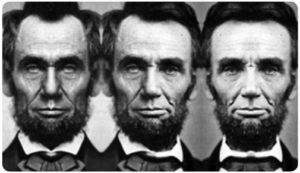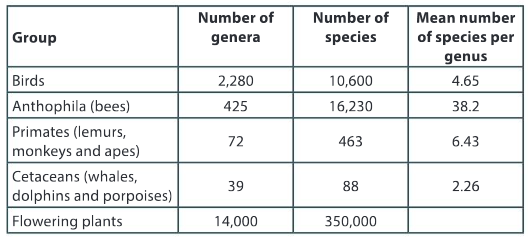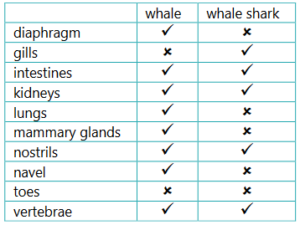Question:
Use the dichotomous key to recognize the different types of cedar shown in the photos A–D.

▶️Answer/Explanation
Ans: There is an error in the key in the book: the number at the end of the first line of the key should be 2, not 1.
A: Cedrus deodara – this may key out as Cedrus libani because the photos have been printed at two–thirds life size, rather than life size. If possible use real specimens for this exercise.
B: Cedrus atlantica
C: Very hard to discern from the photo – there are no translucent glands, the foliage has white streaks and the smell was of pineapple so this is Thuja plicata – see question 5.
D: Cryptomeria japonica
Question:
Every species of organism is given a binomial, consisting of a genus and a species name. What is the genus and the species name for Western red cedar?
▶️Answer/Explanation
Ans: Genus name is Thuja and species name is plicata.
Question:
Some species included in the key have the same genus name. Give an example and explain the reasons for this.
▶️Answer/Explanation
Ans: Cedrus species or Thuja species; species in a genus are closely related/are similar in their traits.
Question:
All the species in the key are types of cedar according to their English name. Explain the reasons for:
a) them being regarded as types of cedar
▶️Answer/Explanation
Ans: They all have light, strong, durable wood that is resistant to pests, decay and fire and has been used in similar ways.
b) them being classified in several different genera and not all together in the same genus.
▶️Answer/Explanation
Ans: They are not all closely related; they show significant differences in traits other than their wood.
Question:
This key includes smells as distinguishing features. Suggest reasons for smells of plants not usually being used in identification keys.
▶️Answer/Explanation
Ans: Smell is rather subjective; smell cannot be detected in photographs; smell may fade over time in museum specimens.
Question:
Same or different?
Predict whether the five species shown in the photographs are placed in the same or different groups and then test your prediction by finding the classification using the Catalogue of Life website.

▶️Answer/Explanation
Ans:
- All five species are in Kingdom Animalia; Phylum Chordata; Class Reptilia.
- Komodo dragon and eastern brown snake are both in Order Squamata.
- Spectacled caiman and green turtle are both in Order Testudines.
- ll five species are in different families.

Question:
Describe the similarities in form between gillaroo, sonaghen and ferox shown in the illustrations of them.
▶️Answer/Explanation
Ans: Same body shape; same arrangement of fins; all have scales/gill slits/eyes; all have spots.
Question:
Deduce whether there has been interbreeding between the three forms of trout in Lough Melvin.
▶️Answer/Explanation
Ans: No interbreeding; no overlap between features in the ordination.
Question:
Discuss whether the three forms of Lough Melvin trout are separate species or not.
▶️Answer/Explanation
Ans: Recognizably different; do not interbreed; have separate ecological niches; so could be regarded as separate species; but very similar in form/ differences rather superficial; not separated for very long/not enough time for speciation; would probably produce fertile offspring if they bred together; perhaps not yet separate species.
Question:
Discuss the significance of the ordination of brown trout from Lough Eske.
▶️Answer/Explanation
Ans: Trout from Lough Eske overlap in characteristics with Sonaghen and Gillaroo; suggesting they have common ancestry; less likely that the Lough Melvin trout really are separate species yet.

Question:
Which is the normal photo and which show the left side and right sides of the face?
▶️Answer/Explanation
Ans: Central photo is normal; photo on left shows only right side; photo on right shows only left side.
Question:
Give three examples of differences in form between the left and right sides of Lincoln’s face.
▶️Answer/Explanation
Ans: Right cheek hollower; wart/cyst/protuberance to left of mouth; fold /protuberance on right side of forehead.
Question:
What conclusion can you draw about Lincoln’s face?
▶️Answer/Explanation
Ans: It is asymmetrical; it changed during his lifetime due to random events.
Question:
Suggest other parts of the body where the left and the right sides are different in:
a) external form
▶️Answer/Explanation
Ans: Right arm thicker than left/vice versa for left-dominant people; right/left breast larger/ lower; leg length difference; right testis larger than left; left testis hangs lower than right.
b) internal form.
▶️Answer/Explanation
Ans: Left side of heart stronger; left and right sides of heart connected to different blood vessels; bulk of liver on right side; pancreas/spleen on left; ascending colon/appendix on left side; descending colon on right; right kidney higher.
Question:
Are there significant differences in form between humans?
Remember that skin and hair colour are not usually considered to be part of form because they are not differences of structure.
▶️Answer/Explanation
Ans: Differences in form seem significant to us because we spend much time looking at each other; but objectively they are very small; levels of genetic variation indicate that there is more difference in form in other species such as chimps which to us all look rather similar.
Question:
Are there more differences or more similarities in form between humans?
▶️Answer/Explanation
Ans: More similarities – we don’t differ as much as we think we do.
Question:
Our physical form is part of our identity. What other parts of our identity are there?
▶️Answer/Explanation
Ans: Personality, relationships/family/community, profession/hobbies/skills, nationality, race, language, memories etc.
Question:
What are the similarities in form between human hands and the hands of orangutan, bonobos and gorillas?
▶️Answer/Explanation
Ans: Palm and five digits; thumb and four fingers; finger nails; two joints in each finger and one at the base; creases in the palm.
Question:
What are the differences in form between these hands?
▶️Answer/Explanation
Ans: Human hands are the smallest; palm relatively shorter in human hands.
Question:
Considering other aspects of the external form of orangutan, bonobos and gorillas, are there more similarities or more differences between them and humans?
▶️Answer/Explanation
Ans: More similarities than differences.
Question:
The great apes are currently classified in four different genera: Pan, Pongo, Gorilla and Homo. How do we decide whether some of the species should be classified together in the same genus?
▶️Answer/Explanation
Ans: Assessment of the similarities/differences; no objective method of deciding.
Splitting and lumping
The number of species per genus varies from 1 to over 1,000. For example, the bee genus Andrena consists of over 1,300 species The table shows current estimates for how many species have been described and how many different genera they are classified into.

Question:
Calculate the mean number of species per genus of flowering plants.
▶️Answer/Explanation
Ans: 25 species per genus.
Question:
Suggest reasons for a high number of species per genus in the Anthophila.
▶️Answer/Explanation
Ans: Both have internal skeleton/endoskeleton; both have individual units in the skeleton; bone in flipper and cartilage in fin; fewer bones in flipper than plates/rods/rays in fin.
Question:
Suggest reasons for a higher mean number of primates per genus than cetaceans.
▶️Answer/Explanation
Ans: 
Question:
Suggest reasons for the larger mean number of species per genus in the flowering plants than in the birds.
▶️Answer/Explanation
Ans: Should be placed together in a phylum with other vertebrates/chordates; but should not be in the same class because there are significant differences; sharks have always lived in water
whereas whales evolved from terrestrial mammals that returned to water.
Question:
Monocot or dicot?
Are the the four plant species in the photos monocots or dicots?
What other monocots and dicots can you find growing near your school?

▶️Answer/Explanation
Ans:
- Tradescantia virginiana and Erythronium grandiflorum are monocots.
- Syringa vulgaris and Hibiscus waimeae are dicots.
Summative assessment: Human hands
Question:
The X-ray shows the bones in a human hand. There are 27 bones in the hand including 8 in the wrist. Use the X-ray to count how many bones are in the palm of the hand (metacarpals) and in
each digit (phalanges).
▶️Answer/Explanation
Ans: Three bones in the thumb; three bones in each finger; five metacarpals in the palm (2 + 3 × 4 + 5 + 8 = 27).
Question:
Discuss whether the hand is a tissue of the body, an organ, or a system.
▶️Answer/Explanation
Ans: Organ; because it consists of a group of tissues that together perform a function.
Question:
A small number of other animal species have opposable thumbs including the other great apes, gibbons, African and Asian monkeys, and also koalas. Discuss whether all animals with opposable thumbs should be classified together in one group.
▶️Answer/Explanation
Ans: Should not be classified together; because that would be an artificial classification based only on one character; other characteristics show that animals with opposable thumbs are not all closely related; koalas not closely related to apes and monkeys; opposable thumbs have evolved more than once.
Question:
Fingerprints are due to ridges on the last segment of each finger. They are so variable that every human is assumed to have fingerprints with a different form, even identical twins.
A few other species have fingerprints including gorillas, chimpanzees and fishers (Martes pennanti) which are carnivorous relatives of weasels. Koalas have fingerprints that are so similar in
form to human ones that they are difficult to distinguish. Using this information, evaluate whether fingerprints can help to assess closeness of relationship.
▶️Answer/Explanation
Ans: Not useful for assessing closeness of relationship; only a single characteristic; classification should be based on comparison of many characteristics; fingerprints have evolved repeatedly; animals with fingerprints may not have common ancestry.
Question:
Explain the difference between the form of an organism and forms of a species.
▶️Answer/Explanation
Ans: Form of an organism is its shape; and its structure; forms of a species are different varieties.
Investigating the development of the hand
Question:
The relative length of the various fingers of the hand is variable in humans. The 2D/4D ratio is calculated by dividing the length of the 2nd (index) finger by the length of the 4th (ring) finger.
Many hypotheses have been suggested for correlations between 2D/4D ratio and other human traits such as ability in sport. Carry out an investigation in these stages:
a) Formulate a testable hypothesis.
▶️Answer/Explanation
Ans: Suitable hypothesis is suggested; hypothesis is testable; hypothesis is based on scientific reasoning.
b) Design a scientific investigation to test your hypothesis.
▶️Answer/Explanation
Ans: Design should include clear statement of independent, dependent and control variables, rationale for the method and practical details, consideration or ethics and risks with marks awarded on a scale from 0 marks for a completely inadequate design to ten marks for an exemplary design.
c) Collect data and analyse it.
▶️Answer/Explanation
Ans: Marks should be awarded on a scale from 0 marks for no valid data collected or analysed up to ten marks for sufficient valid and reliable data collected, displayed in a results table and then analysed to obtain means and ranges, with an appropriate chart to display them.
d) Evaluate the validity of your hypothesis based on your data.
▶️Answer/Explanation
Ans: Marks should be awarded on a scale from 0 where the results are not considered in the light of the hypothesis, up to four marks where there is a careful and full assessment of whether the data provides support for the hypothesis or not.
Question:
Human hands start to develop at an early stage of embryonic development. By day 32 of normal development, 8 mm long paddle-shaped hand plates have formed with no signs of a thumb
or fingers. By day 52, there are separate digits and the hand is 23 mm long. Digit formation is accomplished by the programmed death of some cells and the growth and division of other cells.
Sometimes babies are born with a deformity of the hands. Gene mutations can affect development of the digits. Polydactyly is having an extra finger or thumb. Syndactyly is the condition where two or more digits are fused together.

Draw diagrams, based on those shown above to explain how polydactyly and syndactyly could develop in an embryo.
▶️Answer/Explanation
Ans: Marks should be awarded on a scale from 0 for invalid diagrams to 5 marks for polydactyly shown due to programmed cell death occurring in more than four regions and syndactyly to fewer than four such regions where programmed cell death occurs.
Question:
The drug thalidomide was used in some countries between 1957 and 1961 to treat nausea and morning sickness in pregnant women. Thalidomide caused abnormal development of the arms
and hands in over 10,000 children whose mothers took the drug during pregnancy.
▶️Answer/Explanation
Ans: Unrestricted sale of thalidomide in Germany was unsafe; prescription of thalidomide by doctors in the UK was a mistake; willingness of the drug company to allow thalidomide use in pregnant women was a mistake; refusal of the drug company to undertake trials in pregnant women was a mistake; the assumption without evidence that thalidomide could not cross the placental barrier was a mistake.
Hands and identity
Question:
Countless images of hands have been produced. Two are shown here: a drawing of praying hands by Albrecht Dürer and hands that are part of a sensory homunculus in which parts of the body are sized according to the area of cortex in the brain that receives sensory information from them. Discuss how well each of the two images helps us understand our identity.
▶️Answer/Explanation
Ans: Durer drawing conveys human emotion to us; Durer drawing conveys the changes that occur to us with age; Durer drawing conveys the beauty of human form to us; sensory homunculus shows how much sensation we get from different parts of the body; sensory homunculus shows that hands/lips/tongue contain many sensory nerve endings; sensory homunculus shows that legs/arms are relatively insensitive.
